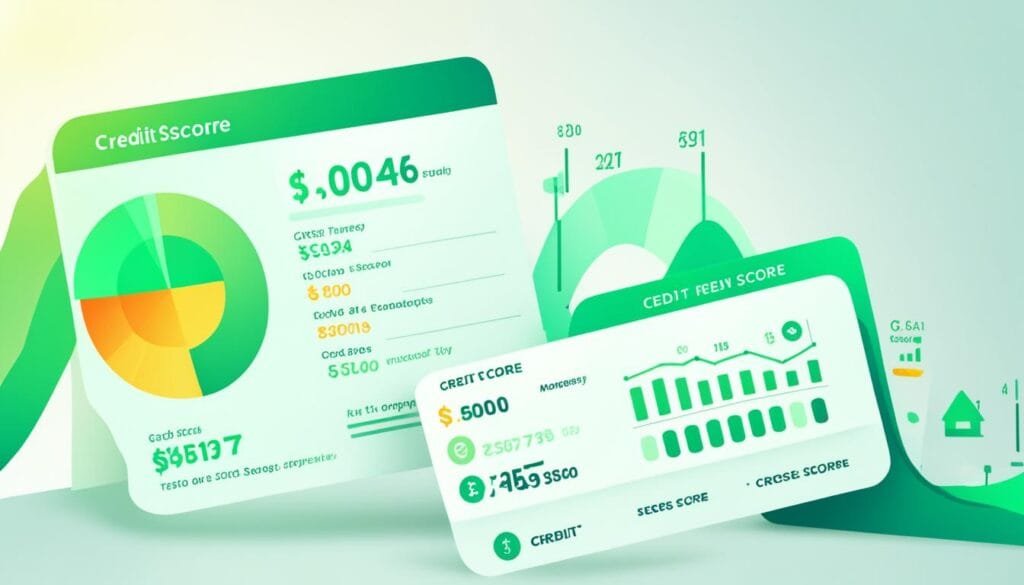Bankruptcy can have long-lasting effects on your credit and financial prospects. The road to recovery may seem daunting, but with the right strategies and resources, you can rebuild your financial life and improve your credit score. In this article, we will provide you with expert advice and tips on bankruptcy recovery, including steps to take after bankruptcy, rebuilding credit, creating a budget, and maintaining financial stability.
Imagine this – Meet Sarah, a hardworking individual who found herself overwhelmed by mounting debts and financial obligations. Despite her best efforts, she wasn’t able to keep up with the payments, and eventually, Sarah had to file for bankruptcy. It was a difficult decision, but she knew it was necessary to get a fresh start.
After the bankruptcy discharge process, Sarah was determined to rebuild her financial future. She dove into researching bankruptcy laws and procedures, determined to chart a path towards financial rehabilitation. She learned about the various post-bankruptcy credit repair strategies available and was motivated to take control of her financial situation.
One of the first steps Sarah took after bankruptcy was to gather all the paperwork from her bankruptcy case. She knew that having a thorough understanding of her financial history and the details of her bankruptcy discharge would be crucial in her journey towards recovery. Armed with this information, she was ready to take the necessary steps to rebuild her financial life.
As Sarah embarked on her journey to financial recovery, she knew that rebuilding her credit would be a significant factor. She learned the importance of paying bills on time and explored options such as opening a secured credit card to demonstrate responsible credit management. Sarah also discovered the value of having utility bill payments reported to credit bureaus and utilized credit builder loans to rebuild her creditworthiness.
Creating and following a budget became a key aspect of Sarah’s financial rebuild. She calculated her income, tracked her spending, and identified her financial priorities. By following the 50/30/20 budget rule, Sarah allocated her income towards needs, wants, and savings, ensuring she was on track to achieve her financial goals.
Throughout her journey, Sarah kept a close eye on her credit reports. She regularly monitored them, checking for errors and inaccuracies. If she found any discrepancies, she promptly disputed the information with the credit bureaus, providing supporting documentation to rectify any mistakes. Sarah also stayed vigilant against credit-repair scams, ensuring she was not taken advantage of during her credit repair process.
As Sarah rebuilt her financial life, maintaining stable employment and housing became incredibly important. She knew that lenders considered her employment history and income stability when assessing loan applications. By demonstrating a reliable source of income and consistent housing, Sarah increased her chances of being approved for loans and building a positive credit profile.
Finally, building an emergency fund and achieving financial stability became a top priority for Sarah. She saved money regularly, followed her budget diligently, and avoided impulse buying. By setting up automatic payments and gradually building an emergency fund, Sarah provided herself with a safety net to handle unexpected expenses without resorting to credit.
Through her determination and the strategies she implemented, Sarah successfully rebuilt her financial future after bankruptcy. She now enjoys financial stability, a positive credit profile, and the peace of mind that comes with being in control of her finances.
Key Takeaways:
- After bankruptcy, gather all the necessary paperwork from your case to understand your financial history and the details of your discharge.
- Rebuilding credit after bankruptcy requires consistent payment of bills and exploring options such as secured credit cards and credit builder loans.
- Create and follow a budget to prioritize your financial goals and allocate your income effectively.
- Regularly monitor your credit reports for errors and inaccuracies, promptly disputing any discrepancies with the credit bureaus.
- Maintain stable employment and housing to strengthen your financial profile in the eyes of lenders.
- Build an emergency fund to handle unexpected expenses and achieve financial stability.
Steps to Take After Bankruptcy
After filing for bankruptcy, there are several important steps you should take to set yourself up for a successful financial recovery. By following these steps, you can begin to rebuild your financial life and achieve long-term stability.
Saving Paperwork from Bankruptcy Case
It is crucial to save all paperwork from your bankruptcy case for future reference. This includes documents such as court filings, discharge notices, and creditor correspondence. Having these records readily available can help you navigate any post-bankruptcy issues that may arise and provide proof of your bankruptcy status if needed.
Building a Budget After Bankruptcy
One of the first steps towards financial recovery is building a budget. This will help you track your expenses, prioritize savings, and regain control of your finances. Start by identifying your essential expenses, such as housing, utilities, and debt repayment. Then allocate a portion of your income towards savings and non-essential expenses. There are several budgeting tools and apps available to help you streamline this process.
Reestablishing Good Credit
Rebuilding your credit is crucial after bankruptcy. Start by paying all bills on time, including rent, utilities, and other recurring expenses. Consider applying for secured credit cards, which require a deposit and can help you demonstrate responsible credit usage. As you rebuild your credit, be sure to regularly monitor your credit reports to ensure accuracy and track your progress.
Monitoring Credit Reports
Monitoring your credit reports is essential to ensure accuracy, prevent identity theft, and track your progress in rebuilding your credit. Regularly check all three major credit bureaus—Equifax, Experian, and TransUnion—for any errors or discrepancies. If you find inaccuracies, dispute them promptly to have them corrected.
Maintaining Job and Home Stability
Having stable employment and housing demonstrates financial stability and can positively impact your creditworthiness. Aim to maintain steady employment and avoid unnecessary job changes, as this can raise concerns among lenders. Similarly, strive to maintain consistent housing and avoid frequent moves, as this stability can help boost your financial profile.
Creating an Emergency Fund
An emergency fund is crucial for financial security and can help you avoid relying on credit in the event of unexpected expenses. Start by setting aside a portion of your income specifically for emergencies. Aim to gradually build up an emergency fund that can cover at least three to six months of essential living expenses. This fund will provide a safety net and peace of mind as you navigate your financial recovery.
| Steps to Take After Bankruptcy | SEO Keywords |
|---|---|
| Saving paperwork from bankruptcy case | paperwork from bankruptcy case |
| Building a budget after bankruptcy | building a budget after bankruptcy |
| Reestablishing good credit | reestablishing good credit |
| Monitoring credit reports | monitoring credit reports |
| Maintaining job and home stability | maintaining job and home |
| Creating an emergency fund | creating an emergency fund |
Rebuilding Credit After Bankruptcy
Rebuilding your credit after bankruptcy is a crucial step in your financial recovery journey. By implementing effective strategies, you can gradually rebuild your credit and improve your overall financial health. Here are some key strategies to consider:
Paying Bills on Time
Consistently paying your bills on time is essential for establishing a positive payment history. Timely bill payments demonstrate your commitment to meeting your financial obligations and can help rebuild your credit over time.
Opening Secured Credit Card
Consider opening a secured credit card to demonstrate responsible credit management. With a secured credit card, you provide a security deposit that serves as collateral for the credit limit. By using the card responsibly and making regular payments, you can rebuild your credit while establishing a positive credit history.
Having Utility Bill Payments Reported
Explore options to have your utility bill payments reported to credit bureaus. While utility bills typically do not appear on credit reports, some companies offer programs that report payments to credit bureaus. Having these payments reported can help showcase your positive payment history.
Utilizing Credit Builder Loans
Credit builder loans are specifically designed to help individuals rebuild their credit. These loans often have lower risk for lenders and can assist you in establishing creditworthiness. By consistently making payments on time, you can showcase your reliable repayment behavior.
Monitoring Credit Reports
Regularly monitoring your credit reports is crucial for ensuring accuracy and identifying any errors or discrepancies. By reviewing your credit reports from all three major credit bureaus, you can address any inaccuracies promptly and maintain a clear understanding of your credit status.
Maintaining Job and Home
Stable employment and housing are important factors in rebuilding your credit. Lenders consider your employment history and income stability when assessing your creditworthiness. By maintaining a steady job and consistent housing, you can demonstrate financial stability to potential lenders.
Making an Emergency Fund
Creating an emergency fund is an essential part of your financial recovery after bankruptcy. By setting aside funds for unexpected expenses, you can avoid relying on credit during emergencies. Aim to save three to six months’ worth of necessary living expenses to ensure you have a safety net in place.
Remember, rebuilding your credit takes time and patience. By following these strategies and practicing responsible financial habits, you can gradually rebuild your credit and pave the way for a brighter financial future.

Creating and Following a Budget
Creating and following a budget is an essential part of financial recovery after bankruptcy. By actively tracking your income and expenses, you can regain control of your finances and work towards your financial goals. Here are the key steps to create and maintain a budget:
- Calculating Income: Start by calculating your monthly income, including any salary, wages, and additional sources of earnings.
- Tracking Spending: Keep track of all your expenses for a month. This helps identify areas where you can make adjustments and save money.
- Identifying Financial Priorities: Determine your financial priorities, such as paying off debt, building an emergency fund, or saving for specific goals.
- Creating a Budget: Allocate your income towards needs, wants, and savings based on your financial priorities. One popular budgeting approach is the 50/30/20 rule, where 50% of your income goes towards needs, 30% towards wants, and 20% towards savings.
- Using Budgeting Apps: Explore budgeting apps like Mint, YNAB, or EveryDollar, which can automate the process and provide insights into your spending patterns.
With a budget in place, you can make informed financial decisions and avoid overspending. Stick to your budget by regularly reviewing and adjusting it as needed. Remember, your budget is a flexible tool that should adapt to changes in your income, expenses, and financial goals.
“A budget is telling your money where to go instead of wondering where it went.” – Dave Ramsey

| Needs | Wants | Savings |
|---|---|---|
| Housing | Dining Out | Emergency Fund |
| Utilities | Entertainment | Retirement |
| Transportation | Travel | Education Fund |
| Insurance | Clothing | Debt Repayment |
The table above illustrates an example of how you can allocate your income among needs, wants, and savings using the 50/30/20 budget rule. Customize your budget based on your specific financial situation and goals.
Monitoring and Maintaining Credit Reports
After bankruptcy, it is crucial to regularly monitor your credit reports to ensure accuracy and identify any potential errors. By monitoring your credit reports, you can stay informed about your financial status and take appropriate steps to improve it.
Start by checking your credit report from all three major credit bureaus – Equifax, Experian, and TransUnion. Review the information provided and verify that the discharged debt is correctly reported. Pay close attention to the details, such as the dates, account balances, and creditor information.
If you find any errors or inaccuracies, take immediate action to dispute the information. Contact the credit bureaus in writing and provide them with supporting documentation that proves the inaccuracies. It is essential to keep records of all correspondence and follow up until the inaccuracies are resolved.
“Regularly monitoring your credit reports can help you catch errors early on and prevent potential issues in the future. It’s important to stay proactive and vigilant when it comes to your credit.”
It is equally important to stay vigilant against credit-repair scams. Be aware of warning signs such as upfront payment requirements, false promises of an instant credit fix, and any practices that seem illegal or unethical. Protect yourself by staying informed and seeking assistance from reputable credit counseling agencies if needed.
Remember, maintaining an accurate credit report is a crucial part of your financial recovery journey. By monitoring your credit reports, checking for errors, disputing inaccurate information, and staying vigilant against credit-repair scams, you can take control of your creditworthiness and rebuild your financial future.
Maintaining Stable Employment and Housing
One of the key factors in achieving financial recovery after bankruptcy is maintaining stable employment and housing. Lenders carefully consider your employment history and income stability when reviewing loan applications. Therefore, it is crucial to demonstrate a reliable source of income and a consistent housing situation. By emphasizing job stability, reliable income, and consistent housing, you can increase your chances of being approved for future loans and build a positive credit profile.
The Importance of Job Stability
Employment stability plays a significant role in your financial recovery. Lenders prefer borrowers with a consistent employment history, as it indicates reliability and the ability to meet financial obligations. Therefore, it is advisable to avoid frequent job changes or extended gaps in employment, as this may raise concerns among lenders. By maintaining a steady job and showcasing a stable employment history, you can enhance your credibility as a borrower.
Ensuring Reliable Income
Having a reliable source of income is crucial for your financial stability and loan eligibility. Lenders want assurance that you can consistently meet your financial obligations. When applying for loans, having a steady income from stable employment demonstrates your ability to repay borrowed funds. It is essential to provide clear documentation of your income, such as pay stubs or tax returns, to showcase your financial stability.
Prioritizing Consistent Housing
In addition to job stability and reliable income, consistent housing is equally important for lenders. Stable housing indicates stability and responsibility, factors that lenders consider when evaluating loan applications. It is advisable to maintain your current housing situation for a considerable period, showcasing your ability to meet ongoing housing expenses. This may include rent payments or mortgage installments. By demonstrating consistent and responsible housing, you can strengthen your overall financial profile.
| Income Considerations for Lenders | ||
|---|---|---|
| Job Stability | Reliable income | Consistent housing |
| Prefer borrowers with a consistent employment history | Assurance that borrowers can consistently meet financial obligations | Indication of stability and responsibility |
| Avoid job changes or extended gaps in employment | Provide clear documentation of income | Maintain current housing situation for a considerable period |
By maintaining stable employment and housing, you demonstrate financial responsibility and improve your chances of obtaining future loans. This, in turn, allows you to rebuild your credit and work towards achieving long-term financial stability after bankruptcy.
Building Emergency Fund and Financial Stability
Building an emergency fund and achieving financial stability are vital steps towards recovering from bankruptcy. It is crucial to take proactive measures to protect yourself from unexpected expenses and potential financial setbacks. By following the strategies outlined below, you can establish a solid foundation for your financial future.
Saving Money Regularly
One of the key pillars of financial stability is saving money consistently. Allocate a portion of your income for savings and make it a priority. Consider automating your savings by setting up automatic transfers from your checking account to a separate savings account. This will help you save efficiently and avoid the temptation to spend the money.
Following a Budget
A budget is an indispensable tool for controlling your spending and achieving financial stability. Create a budget that outlines your income and expenses, ensuring that your expenses are aligned with your financial goals. Track your spending and identify areas where you can cut back or make adjustments. Prioritize saving and allocate a portion of your income towards your emergency fund.
Avoiding Impulse Buying
Impulse buying can quickly derail your financial stability goals. Before making a purchase, consider if it aligns with your budget and financial priorities. Take the time to evaluate whether the item is a necessity or if it can be postponed. Avoid making impulsive decisions and focus on long-term financial well-being.
Setting Up Automatic Payments
Staying on top of your bills is essential for financial stability. Consider setting up automatic payments for recurring expenses such as utility bills, rent or mortgage payments, and loan installments. This will help you avoid late fees, improve your credit standing, and maintain a consistent payment history.
Creating an Emergency Fund
An emergency fund serves as a financial safety net in times of unexpected expenses. Aim to save three to six months’ worth of necessary living expenses in your emergency fund. This fund will provide you with peace of mind and financial security if you face a job loss, medical emergency, or any other unforeseen circumstances.
Tip: Keep your emergency fund separate from your regular savings account to ensure it remains untouched unless absolutely necessary.
By saving money regularly, following a budget, avoiding impulse buying, setting up automatic payments, and creating an emergency fund, you can establish a solid financial foundation and achieve lasting stability. These steps will not only help you recover from bankruptcy but also set you on the path to long-term financial success.
What Are the Best Strategies for Rebuilding Finances After Bankruptcy?
Rebuilding your finances after bankruptcy requires effective financial recovery strategies. Creating a budget, sticking to it, and rebuilding your credit are crucial steps on the path to fiscal health. Seeking professional financial advice and avoiding unnecessary debt can also contribute to a successful recovery journey.
Conclusion
Recovering from bankruptcy is a challenging journey that requires dedication and strategic financial planning. By following the expert advice and implementing the steps outlined in this article, you can begin the process of rebuilding your financial future and achieving long-term stability.
Start by saving all the necessary paperwork from your bankruptcy case. This documentation will serve as a reference point and may be required for future financial transactions. Alongside this, focus on rebuilding your credit. Make timely bill payments, consider opening a secured credit card, and explore options to have utility bill payments reported to credit bureaus. Regularly monitoring your credit reports will help you stay on top of any inaccuracies or errors that may arise.
Creating and following a budget is essential for regaining control of your finances. Calculate your income, track your spending, and allocate funds towards your needs, wants, and savings. Use budgeting apps or simple spreadsheets to track your progress and stay committed to your financial goals.
Additionally, maintaining stable employment and housing is crucial for financial recovery after bankruptcy. Lenders consider your employment history and income stability when assessing loan applications, so strive to maintain a reliable source of income and stable housing. Lastly, building an emergency fund will provide a safety net for unexpected expenses and help you avoid relying on credit in times of financial stress.
Remember, this journey requires patience and perseverance. Seek professional assistance if needed and stay determined throughout the process. By implementing these strategies, you can rebuild your financial life and achieve the stability and peace of mind you deserve.
FAQ
What are the steps to take after bankruptcy?
After filing for bankruptcy, it is important to save all paperwork from your case, start saving money to establish a financial safety net, build a budget to track expenses and prioritize savings, reestablish good credit by paying bills on time and considering secured credit cards, regularly monitor credit reports for accuracy, maintain stable employment and housing, and set up an emergency fund to prepare for unexpected expenses.
How can I rebuild my credit after bankruptcy?
To rebuild credit after bankruptcy, you can consistently pay bills on time to establish a positive payment history, open a secured credit card to demonstrate responsible credit management, explore options to have utility bill payments reported to credit bureaus, utilize credit builder loans to show creditworthiness, regularly monitor credit reports to ensure accuracy, maintain stable employment and housing, and set up an emergency fund to avoid relying on credit in case of financial emergencies.
How do I create and follow a budget after bankruptcy?
To create a budget, calculate your monthly income, track your spending to identify areas of improvement, prioritize your financial goals, and allocate your income towards needs, wants, and savings. One popular budgeting approach is the 50/30/20 rule, which advises allocating 50% of your income towards needs, 30% towards wants, and 20% towards savings. Budgeting apps can help streamline the process, but even a simple spreadsheet or pen and paper can be effective tools for tracking your expenses and sticking to your budget.
How should I monitor and maintain my credit reports?
It is important to regularly monitor your credit reports to ensure accuracy and identify potential errors. Check your credit report from all three major credit bureaus and verify that the discharged debt is correctly reported. If you find any errors or inaccuracies, promptly dispute the information with the credit bureaus and provide supporting documentation. Keep records of all correspondence and follow up until the inaccuracies are resolved. Stay vigilant against credit-repair scams and be aware of warning signs such as upfront payment requirements, false promises, and illegal practices.
Why is maintaining stable employment and housing important for bankruptcy recovery?
Lenders consider your employment history and income stability when reviewing loan applications, so it is important to demonstrate a reliable source of income and a consistent housing situation. Avoid job-hopping or extended gaps in employment as it may raise concerns among lenders. By maintaining a steady job and dependable housing, you increase your chances of being approved for future loans and building a positive credit profile.
How can I build an emergency fund and achieve financial stability after bankruptcy?
Start by saving money regularly, following a budget to control your spending and avoid impulse buying, consider setting up automatic payments to stay on top of your bills, and gradually build an emergency fund to cover unexpected expenses. An emergency fund should ideally cover three to six months of necessary living expenses and can provide a safety net in case of job loss or other financial emergencies.

